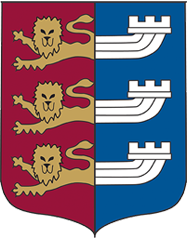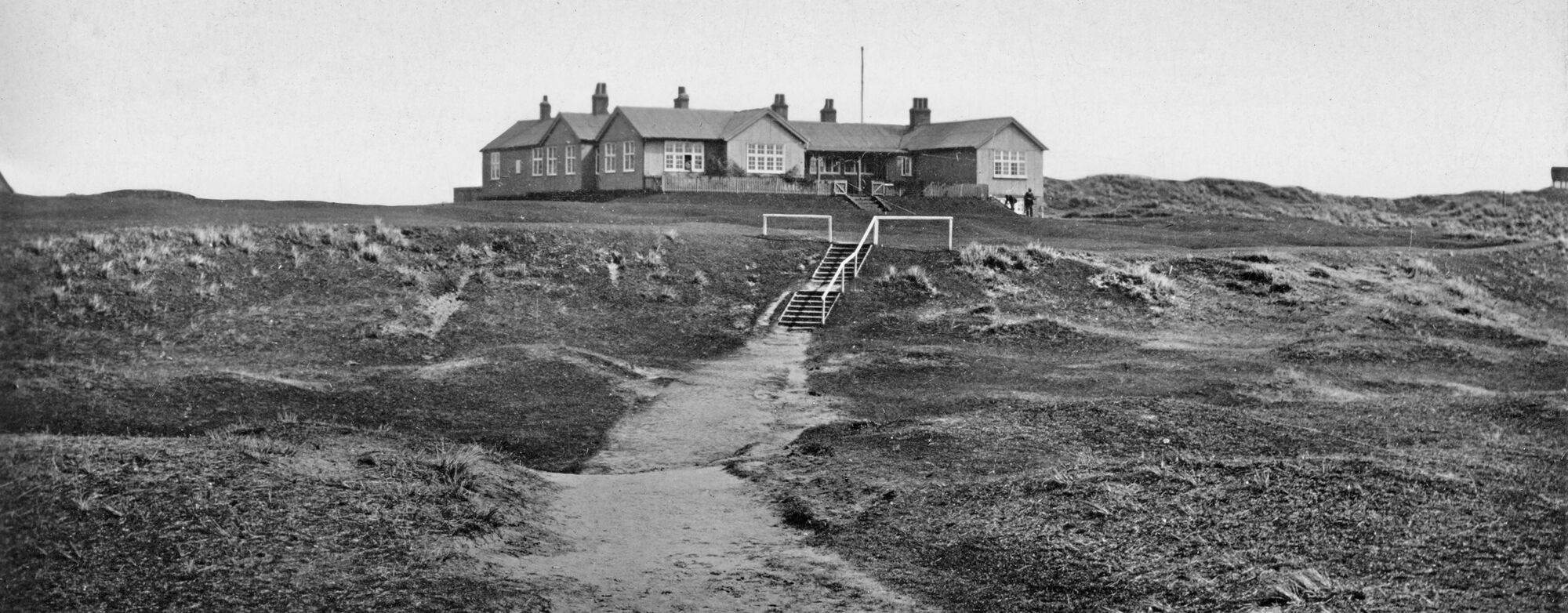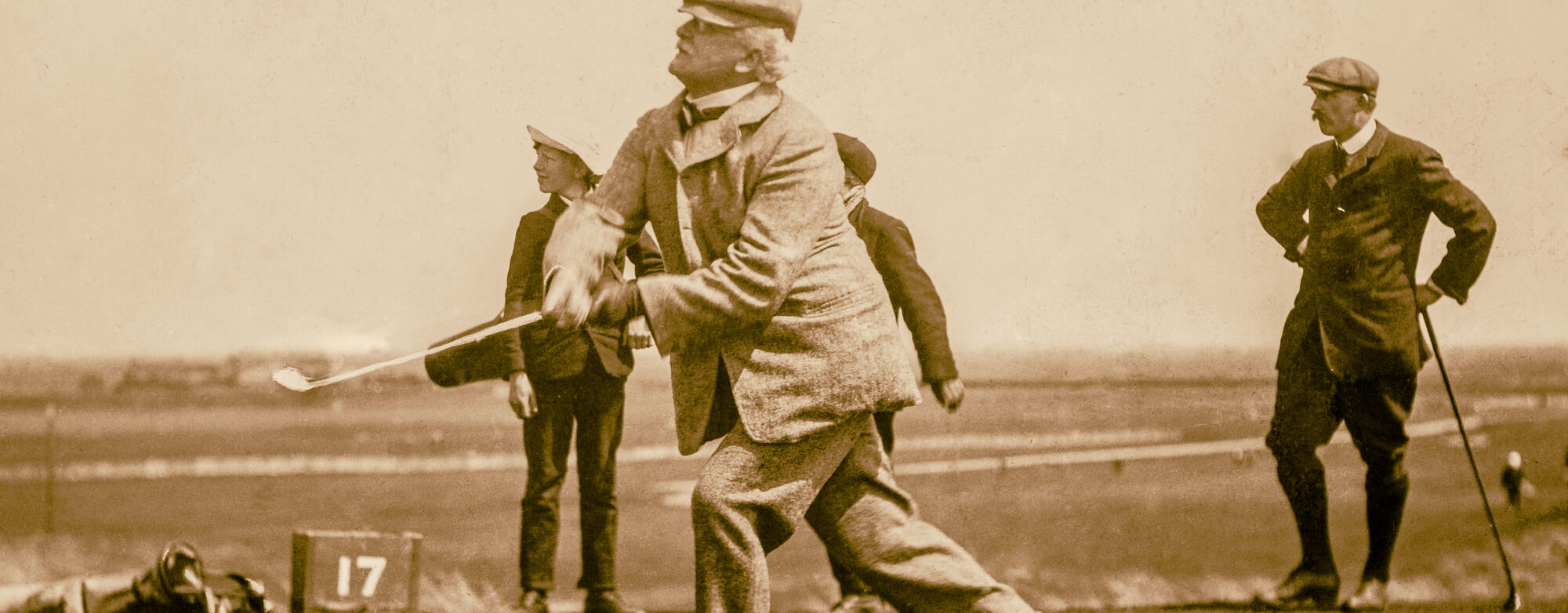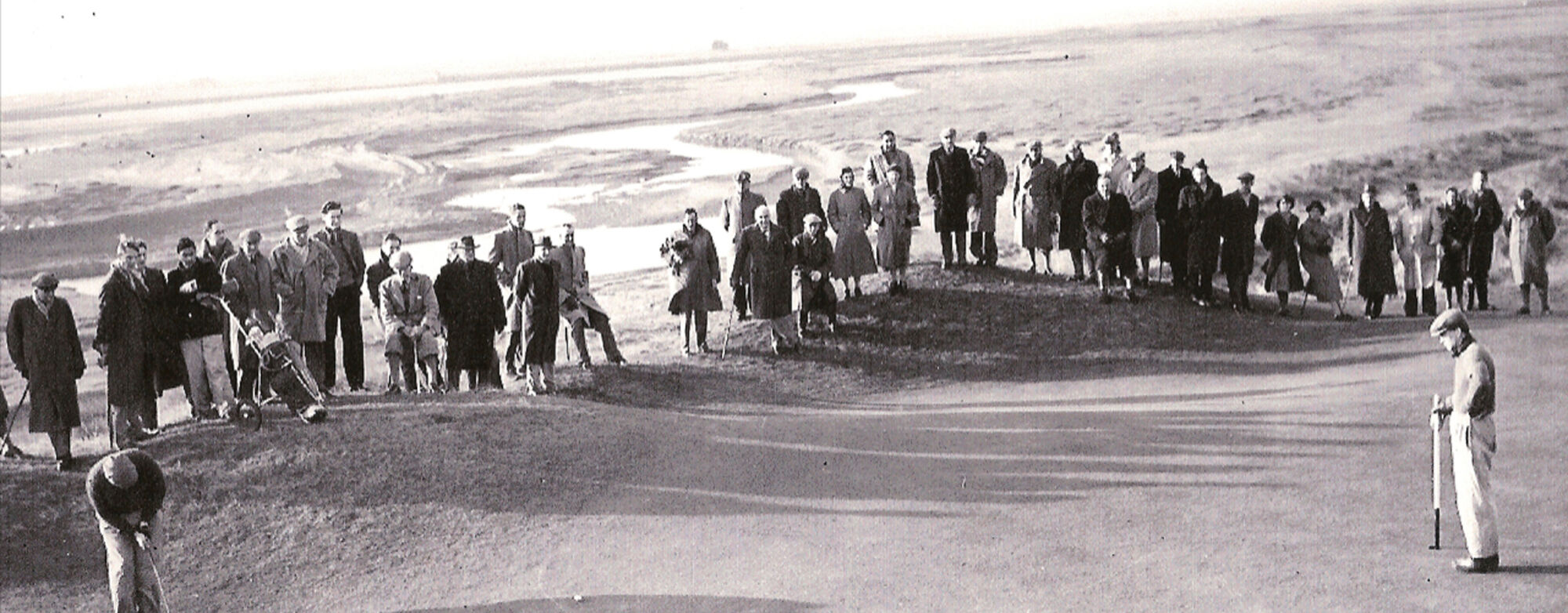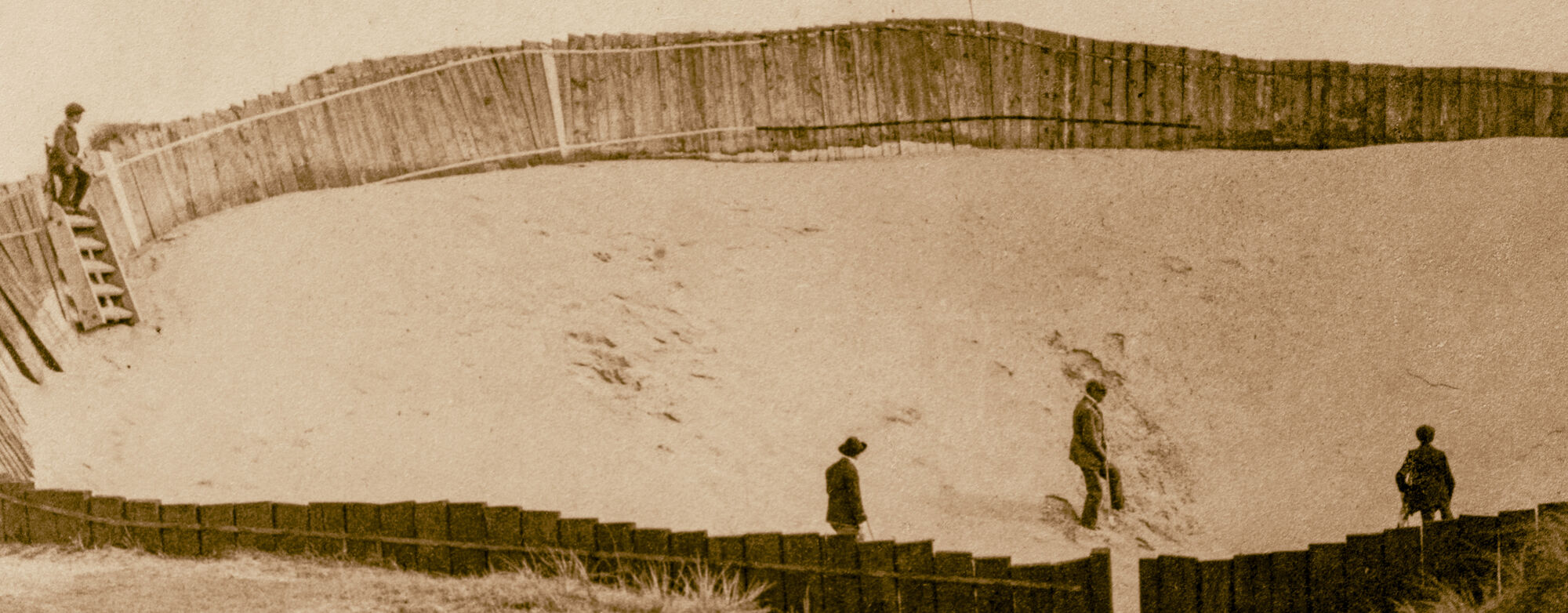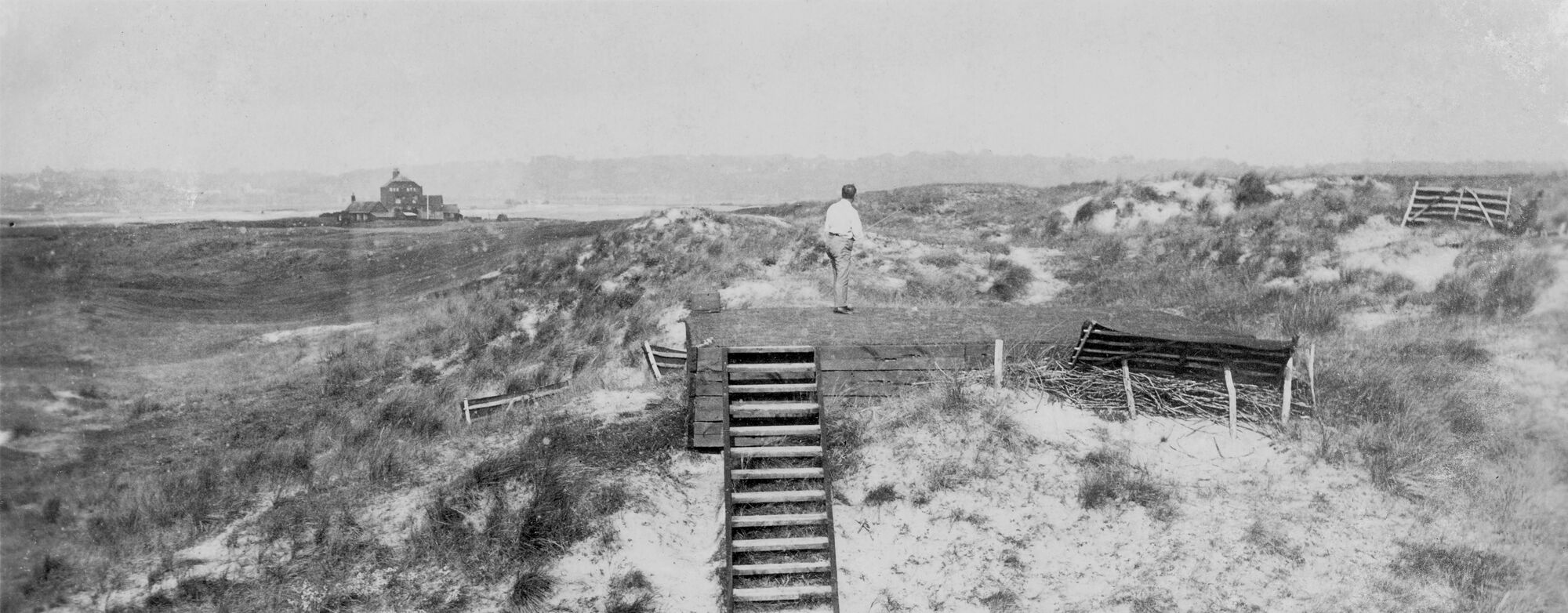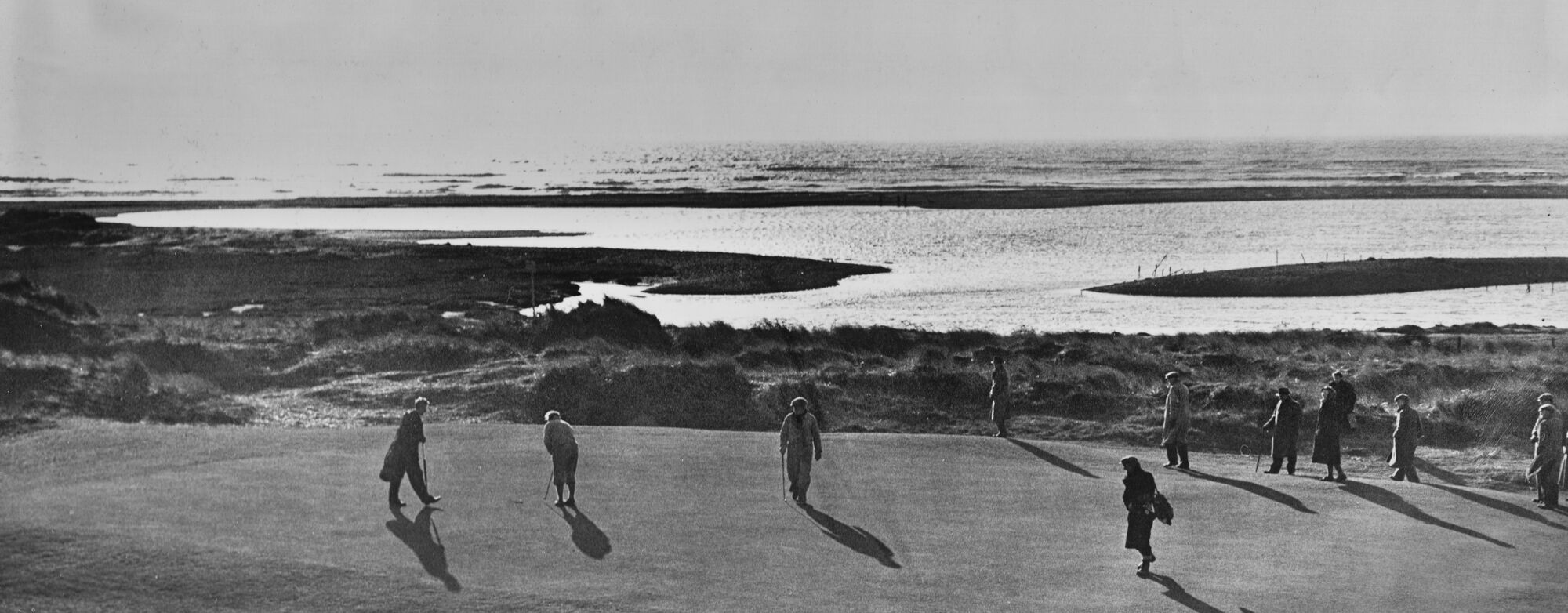Heritage
It is hoped that the following information will be of interest to all who enjoy the history and tradition of golf.

1st hole (378 yards), 1932-33, with the green situated on the flat ground beside and below the current 4th green

Tee to the 2nd hole (480 yards), 1897

J. Lonie, Professional at Rye G.C. (1899-1904) approaching the green to the 10th hole (230 yards), 1904.

3rd hole (470 yards), a dog-leg left, with figures on the green on other side of the road to the Coastguard Cottages.

David Lloyd George, 1st Earl Lloyd-George of Dwfor, O.M., P.C. (1863-1945), Prime Minister of the U.K. (1916-1922), on the tee to the old 17th hole (270 yards), ca. 1910.

Arthur James Balfour, 1st Earl of Balfour, K.G., O.M., P.C. (1848-1930), Prime Minister of the U.K. (1902-05), on the tee to the original 15th hole (175 yards), before 1907. Balfour became a member of Rye G.C. in 1895 just one year after it opened for play.

15th hole either 175 yards (1894) or 429 yards (1907-32), with Michael Scott and R.E. Walker on the same green as today’s 15th hole, pre-1914.

The old 6th hole (385 yards), with golfer and caddy on the tee (up ‘Jacob’s Ladder’), one of three holes on land beyond the Coastguard Cottages.

The old 4th hole (180 yards), golfers and caddies on the green, one of three holes on land beyond Coastguard Cottages. In the distance are golfers near the 5th green approached from a tee to the left, on the other side of the road.

The old 7th hole (520 yards), with a tee behind and between Coastguard Cottages and the current 4th tee, and a dog-leg via the current 3rd fairway to a green near the current 4th green. Cyril Tolley playing his approach to the green, 1920s.

9th hole (340 yards), with tee close to current ladies’ tee, over dunes to the current practise green on the other side of the road, 1922.

9th hole (340 yards), with Ladies’ Clubhouse visible in the distance between the gentleman and two ladies, 1920s.

9th hole (315 yards), with Ladies Clubhouse, 1933.

2nd hole (480 yards), which ran along the edge of the track (later a road), with golfers, caddies and spectator on the green situated about 2/3 of the way down the left edge of the current 3rd fairway, pre-1914.

16th hole (410 yards), with a golfer on the old lower tee situated at the bank between the current 15th green and 18th fairway.

The Golf Links tram station, ca. 1920. Trams ran from 1895-1939 and the building for the Golf Links station can still be seen close to the Rother to the right of the current 12 green and 13th fairway.

The old, short and very short-lived 14th hole (150 yards) with J.E. Palmer Tomkinson on the tee which was sited between the current 13th green and 15th tee looking to a green on the other side of the current 9th fairway, 1920s.

The Clubhouse and Ladies’ Clubhouse viewed from the current 15th tee, 1933.

16th hole (410 yards), with four golfers and a caddy on the green which remains in the same place today, beyond can be seen Tunbridge Cottage, Squatters Right and Gorse Cottage, 1922.

The old 17th hole (270 yards) with Bernard Darwin (1876-1861), celebrated amateur golfer and twice Captain of Rye (1906 and 1956), playing an approach to the green. The players in the background are on the current 11th fairway, pre-1914.

The old 17th hole (270 yards) with J. Lonie, professional at Rye G.C. (1899-1904) approaching the green from Colt’s Nose bunker.

The old 17th hole (270 yards) with golfers and caddies on the green, situated on the current 10th fairway, the old 18th tee and bunker beyond, 1920s.

The old 18th hole (380 yards) with David Lloyd George trapped in the bunker, which was abandoned in 1932 and situated in the large holllow to the left of the current 18th fairway, 1920s.
The Early Years
In the early 1890s, golfers in the Rye and Hastings area discussed the possible creation of a golf course at Camber. A meeting held at the George Hotel in Rye on 28th November 1893, decided that 'a Golf Club should be formed; links to be situated over the Camber sandhills'. Work started immediately, a course was laid out and the first competition took place in February 1894. Read More...
The Rev J.L. Bates, Rector of Iden, was an active Chairman of a committee coordinating the construction of the course and organising the newly formed club. H.S. Colt, a solicitor, was elected as the first Captain and he designed 18 holes in 1895, which became the permanent course. This set him on a new career as a golf course designer of national and international renown.
The adjacent Royal William hotel, then no more than a wooden shack, provided accommodation and meals until a temporary clubhouse was built in 1894. The 'temporary', much altered, building is still in use today.
By the end of the century there were over 250 members, many from London. Lady members were admitted from the start, 32 being enrolled in 1894. The Club prospered in the early years and became well known as one of the leading golf clubs in the south of England.
It counted among its members a Prime Minister, a Cabinet Minister, eminent judges and leading advocates. The famous golf writer Bernard Darwin, who became Captain in 1906, sang the praises of Rye whenever possible.
In 1899 the newly created Oxford and Cambridge Golfing Society accepted an invitation to play their home matches at Rye and the varsity match was first played at Rye in 1911. The special relationship with Oxford and Cambridge exists to this day.
Transport to the club before the days of the popular motor car was solved by the opening of the Rye and Camber Tramway in 1895. The 1¾ mile journey from Rye to the Golf Links Station took 8½ minutes and cost 6p return (first class). The steam tram lost passenger appeal to the motor car in the mid-twenties and, after use by the Admiralty during WW2, the company was quietly wound up.
By 1905 there were 430 men and 60 lady members. The 'temporary' clubhouse was expanded until, by 1911, the outline of the building had assumed its current, much-loved shape. Simple fare was offered in the clubhouse: a cold luncheon supplemented by buttered eggs became the Club's speciality.
In 1907, redesign of the course took advantage of the receding sea by using land to the south of the sandhills and lengthening Colt's original layout. Two holes were still across the road and three holes remained on land beyond the coastguard cottages.
The Club was now flourishing; even the First World War did not check its progress. It is said that the guns on the Western Front could be heard in Rye, but they made little impact on the Golf Club. Several members of the ground and house staff were released to join up but play continued and lunches were served at 'the Billy'. After the war, play soon got back to normal and Rye became a favourite course for leading amateurs of the day.
Between The Wars
In January 1920 the Oxford and Cambridge Golfing Society played the first President's Putter, which became the biggest event in the Rye calendar. Well-known names such as Darwin, Montmorency, Holderness, Tolley, Wethered, Crawley and Micklem, amongst others, appeared regularly in the twenties and thirties. Read More...
By 1932 play on the holes across the Camber Road became too dangerous because of increased traffic and replanning of the course was necessary. T. Simpson did the design and the new Head Greenkeeper, Frank Arnold, did the work. Further major alterations were proposed in 1938, this time by Sir Guy Campbell in conjunction with Arnold who, not only implemented the changes, but made other improvements which turned Rye into one of the finest winter courses in England. Arnold retired at the age of 80 in 1973 having trained his successor, Trevor Ockenden, who remained in post until 2006. Rye has had only three Head Greenkeepers in nearly 100 years.
In 1938 the Artisans' Club was offered a permanent home at Rye and remains in happy relationship with the parent Club. Many Artisans have been good golfers but none more so than W.G. 'Blower' Pierce. He started as a caddy, survived five years as a POW, joined the green staff and, for a decade, dominated Artisan and Sussex golf.
Post Second World War, 1945 - 1999
The second world war affected the club far more than the first world war. Anti-invasion measures saw major defences built on the first nine; the Old Billy was requisitioned; eight holes of the back nine remained in play but, in 1944, a flying bomb badly damaged the clubhouse. Read More...
After a difficult year or two the club got going again. The course was restored from extensive damage and underwent various changes from the pre-war layout. Major Tippet, the then Secretary, is credited with the new 2nd and 7th short holes. In the case of the 7th it was built where a 4-iron played by the Major landed in the dunes. A large dune was levelled to create the green and provided a spectacular hole. The Old course is reputed for the quality of its short holes giving rise to the well-known wry observation that “the hardest part about Rye is the second shots on the short holes.”
The land beyond the coastguard cottages was sold and the club’s finances received a boost when increased income from gravel was negotiated. The Oxford and Cambridge Golfing Society ‘Putter’ competition was played again in 1947 and the clubhouse was eventually repaired and enlarged.
In the early 1960s the 10th hole was changed from a short Par 4 to the longer more demanding current hole. This necessitated moving the 11th tee and a few years later the gravel workings created Squatters’ Pool, which changed the hazard on the right of the 11th from playing off the shingle to a water hazard. Later, a further tee was introduced with a drive over the water.
Automated irrigation on the tees and greens was introduced in the 1960s. This transformed the greens and enabled play throughout the summer.
To provide security of water for the tees and greens, a water storage reservoir, called “Wenway Pool” was constructed in 1997. It is located on the far side of North Point lake on land owned by the club.
The land which now forms the Jubilee course used to flood through a gap in the sea dunes at times of very high water. The gap was closed in the 1960s and this enabled the 9-hole, Jubilee Course, designed by Frank Pennink, to be built and opened in 1977.
The traditional lunches in the 1950s were cold joints of meat, which the members carved and served themselves, preceded by ham and eggs, the only hot food. There was egg rationing at that time so it was restricted to members only. In the 1960s fully cooked lunches were introduced with the kitchen modernised accordingly. Ham and eggs remained on the menu but for several decades were still restricted to members only; the original reason having been forgotten. Food is only served in the dining room and the tradition of carving and serving oneself, which makes it more sociable, has been maintained.
In the 1990s the “Old Billy” (the local affectionate name for what was the Royal Willian Hotel on the opposite side of the road from the clubhouse) was renovated to provide “Dormy” facilities of two flats and three en-suite bedrooms for use by members and guests in addition to the staff accommodation on the ground floor.
Modern Times, 2000 onwards
On the Old course new tees, up to 50 metres behind the existing back tees, were added on several holes. This then comprises a championship course with designated blue tee markers as an attempt to mitigate the challenge of modern golf balls and clubs which give much greater length. Read More...
The surrounds to the 17th hole were reshaped, a new tee and an additional fairway bunker were added to the 12th hole in 2010 and in 2015 a fully automated fairway irrigation system was installed on the Old course.
The Jubilee course often flooded and was out of play during a rainy winter so a drainage scheme was designed and installed in 2001/2002. At the same time the earthworks were carried out for five new holes and two holes were abandoned (one becoming a practice area) all to a design by Donald Steel & Co. The new holes were opened for play in May 2005 providing two loops of 9 holes with 12 holes in total of which six holes are played twice; three from different tees. As part of this upgrade of the course an automated irrigation system was installed for the greens and tees.
To meet a growing demand in the 2000s, golf buggies were permitted for use on the Jubilee course. Storage for two 2-person buggies was provided by converting part of the old Tram Shed.
A review of the Jubilee course was carried out in 2013 by Mackenzie and Ebert which resulted in various amendments to many of the holes to make them more playable, including a new green for the 8th hole which used to share the 17th green.
The Jubilee course now serves as a first class alternative to the Old course and has enabled all the matches in the Oxford and Cambridge Golfing Society Putter Competition to be played at Rye.
The clubhouse has been modified to keep up with the requirements of a thriving club whilst maintaining its unique character. First, the north end was rebuilt to provide a larger dining room with a vaulted ceiling and a dedicated meeting room under it. At the same time a new entrance hall was created and the Secretary’s office was enlarged. The works were completed in 2009.
The south end was modified in 2020/21 to provide a larger men’s locker room with vaulted ceilings by building over the lower floor ladies’ locker room. The trolley shed was incorporated to provide space for upgraded showers and the whole locker room, including the lavatory area, was completely refurbished.
The coastguard cottages, including Chief Coastguards, all of which provide staff accommodation, located behind the 3rd green were modernised and a little later the adjacent Admiralty Cottage was also upgraded.
The courses, which are reputed to be among the very best winter courses in the British Isles, provide year-round challenging links golf of the highest standard. It is a two-ball club, foursomes and singles, played briskly and in most weathers.
"Surely there can nowhere be anything appreciably better than the golf to be had at this truly divine spot."

